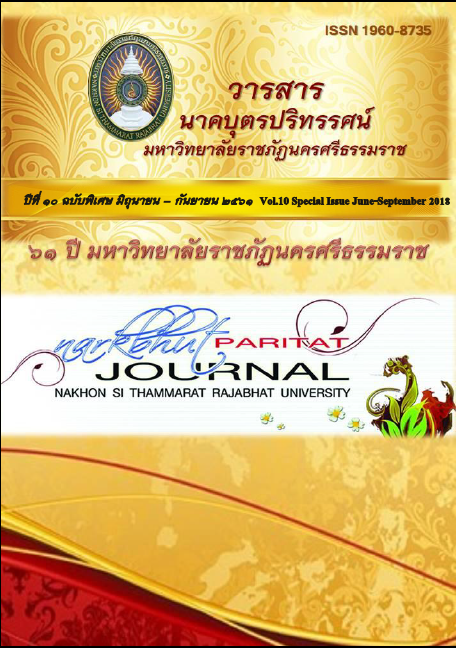การศึกษาความเครียดและวิธีเผชิญความเครียดของนักเรียนระดับมัธยมศึกษาตอนปลาย ในอำเภอเมือง จังหวัดตรัง Study of Stress and Coping Strategies of High School Student in Muang District, Trang Province
Main Article Content
Abstract
The objectives of this research were as followings: 1) to study stress of high school students 2) to compare stress of high school students according to their personal factors. 3) Stress coping strategies of high school students. The participants were high school students in Muang district, Trang province. The population were 3,223 and 356 sampled. The sample selection was based on a stratified random sampling technique with student’s population in each school. Research instrument were questionnaire. The data were analyzed by using statistical methods; including average, percentage, t – test, F – test, and LSD. The statistical significance level was .05. The results had concluded as followings: firstly, most students had stress at high level among of 52.1%. Secondly, difference in gender, education program and job’s mother had contributed to difference to stress with the statistical significance level of .05. 3) The student had the moderate level coping stress with problem focused coping strategies, while had the low level coping stress with emotion focused coping and less focused coping strategies.
Article Details
References
เศรษฐกิจ. วิทยานิพนธ์คุรุศาสตรมหาบัณฑิต สาขาสุขศึกษา, กรุงเทพมหานคร: จุฬาลงกรณ์
มหาวิทยาลัย.
จิราภรณ์ ภู่เทศ และ บารมี บุญทรง. (2555). ค่านิยมเกี่ยวกับการศึกษาของไทย: กรณีศึกษาจากสำนวน
ไทยและข่าวหนังสือพิมพ์. วารสารมนุษยศาสตร์และสังคมศาสตร์, 18 (1), 91-109.
ชนิกานต์ ขำเหมือน. (2559). ความชุกและปัจจัยที่เกี่ยวข้องกับความเครียดของนักเรียนชั้นมัธยม
ศึกษาปีที่ 6 โรงเรียนบุรีรัมย์พิทยาคม. วิทยานิพนธ์วิทยาศาสตรมหาบัณฑิต สาขาการวิจัยและ
การจัดการด้านสุขภาพ. กรุงเทพมหานคร จุฬาลงกรณ์มหาวิทยาลัย.
เชษฐ์สุดา ผิวเผือก. (2558). เหตุผลที่นักเรียนเลือกเรียนแผนการเรียนวิทย์-คณิตของนักเรียนสาย
วิทย์-คณิต โรงเรียนอ้อมน้อยโสภณชนูปถัมภ์. ค้นเมื่อ ธันวาคม 15, 2560, จาก
https://wipaporn1v1486.blogspot.com/2015/02/blog-post.html.
ไทยรัฐฉบับพิมพ์. (2560). นักเรียนฆ่าตัวตาย. ค้นเมื่อ ธันวาคม 15, 2560, จาก https://www.thairath.
co.th/content/1103439.
ประชาชาติธุรกิจ. (2559). นักเรียนฆ่าตัวตาย. ค้นเมื่อ ธันวาคม 15, 2560, https://www.prachachat
.net/news_detail.php?newsid=1458912973
เนตรราตรี ท้าวโสม. ปัจจัยที่ส่งผลต่อความเครียดของนักเรียนชั้นมัธยมศึกษาปีที่ 6 จังหวัด สุพรรณบุรี.
กรุงเทพฯ :มหาวิทยาลัยเกษตรศาสตร์.2555.
สุนิสา ตะสัย. (2550). ความเครียดและการแก้ปัญหาความเครียดของนักเรียนชั้นมัธยมศึกษาตอนปลาย
ในจังหวัดสงขลา. วิทยานิพนธ์ปริญญามหาบัณฑิต สาขาวิชาสร้างเสริมสุขภาพ มหาวิทยาลัย
สงขลานครินทร์.
สุภาภัทร ทนเถื่อน. (2553). การศึกษาความเครียดและวิธีเผชิญความเครียดของนักเรียนมัธยมศึกษา
ตอนปลาย. สารนิพนธสาขาวิชาจิตวิทยาพัฒนาการ. มหาวิทยาลัยศรีนครินทรวิโรฒ.
สุวัฒน์ มหัตนิรันดร์กุล และคณะ. (2540). รายงานการวิจัยเรื่องการสร้างแบบวัดความเครียดสวนปรุง
โรงพยาบาลสวนปรุง จังหวัดเชียงใหม่. ค้นเมื่อ สิงหาคม 17, 2560, https://dmh.go.th/test/
stress/.
เอ็มไทนิวส์. (2559). นักเรียนฆ่าตัวตาย. ค้นเมื่อ ธันวาคม 15, 2560, https://news.mthai.com/gene
ral-news/535107.html
Best, J.W. (1993). Research in Education. Boston, M.A.: Allyn and Bacon.
Cassmeyer, L. (1995). Handbook of Stress: Theorical and clinical Aspect. New York:
FreePress.
Caver, C.S., Scheier, F. M., Weintraub, J. K. (1989). Assessing coping strategy: A theoretically based approach. Journal of Personality and Social Psyhology, 56, 267-283.
Dorland, Neuman W.A. (1994). Dorland‘s Illustrated Medical Dictionary. Philadelphia:
W.B.Sauders.
Jalowiec, A., (2003). The Jalowiec coping scale. Measurement of outcomes, 3,71-87.
Lazarus, R.S., & Folkman, S. (1984). Stress, Appraisal, and Coping. New York: Springer Publishing Company Inc.
Mondy, Wayne R, Arthur Sharplin, & and Edwin B. Flippo. (1988). Mangement: Concept
and practice. 4th ed. Boston: Allyn and Bacon.
Yamane, T. 1973. Statistic: An Introductory Analysis. 3rd ed. New York: Harper&Row.

